Adrian Collins's Blog, page 70
November 18, 2023
An Interview With Jim Butcher
Jim Butcher, the New York Times and USA Today best-selling author of The Dresden Files, which follows Harry Dresden, a private investigator and practicing wizard. The Codex Alera, an epic 6-book finished fantasy series following crafters who can control the elements through a person’s bond with that element. And finally, The Cinder Spires, a steampunk-inspired fantasy world following the war between two different spires, Spire Albion and Spire Aurora, towering miles above a shrouded mist-covered land. Jim will release his second novel in The Cinder Spires universe, The Olympian Affair, on November 7th, 2023.
 During an AMA Jim did on Reddit, Jim described the world of “The Cinder Spires” as “It’s kinda League of Extraordinary Gentlemen meets Sherlock meets Hornblower. There are goggles and airships and steam power and bizarre crystal technology and talking cats, who are horrid little bullies.”
During an AMA Jim did on Reddit, Jim described the world of “The Cinder Spires” as “It’s kinda League of Extraordinary Gentlemen meets Sherlock meets Hornblower. There are goggles and airships and steam power and bizarre crystal technology and talking cats, who are horrid little bullies.”
Jim was kind enough to sit down with questions from Grimdark Magazine and tell us what we have in store for book two.
[GdM] I had the privilege of interviewing your son, James Butcher, last year and loved his debut novel, Dead Man’s Hand. How exciting is it for you to have a son who is now a thriving author in his own right?
[JB] It’s incredibly exciting! In much the same way as being chased by a bear. James’s first published novel was probably as good as my third. His second is as good as my fifth or sixth. He’s going to leave me eating his dust before long, and then I’ll be hoping for crossover readers from his fandom.
[GdM] What books, authors, or fiction works have significantly impacted your writing style and how you approach storytelling?
[JB] I owe great thanks to my writing teacher, Deborah Chester, who taught me everything I really needed to know about writing. Babylon 5 and Buffy the Vampire Slayer also both made big contributions to my initial writing style.
[GdM] Are there any genres or themes you want to explore in your future works? Is there a possible Romance or Horror novel in your head waiting to be released?
[JB] Oh, I’m not a complicated guy. If I was half as mercenary as I like to pretend I am, I’d have been writing mainstream thrillers a long time ago. For me, if the story doesn’t have vampires, ghosts, aliens, monsters, magic or superpowers, I just don’t get the point. Nothing wrong with thrillers, romance, literary or mainstream novels—but I grew up lost in Narnia, Pern, Amber, Gor, Prydain and Krynn. Those places will always be my native lands.
[GdM] Can you talk a bit about the hat joke for Dresden, which is a funny bit of trivia? Are there buried jokes in the covers for The Cinder Spires?
[JB] What hat?  In the books, Dresden doesn’t wear a hat, but way back in the olden days, Penguin’s art department decided that the perfect visual shorthand for a Wizard/Private Investigator would be a guy carrying a wizard’s staff and wearing a fedora.
In the books, Dresden doesn’t wear a hat, but way back in the olden days, Penguin’s art department decided that the perfect visual shorthand for a Wizard/Private Investigator would be a guy carrying a wizard’s staff and wearing a fedora.
I used to tease the artist, Chris McGrath, about the hat, but he bested me in the funniest possible way—in the Cinder Spires, one of the central characters, Francis Madison Grimm, is an airship captain who wouldn’t be caught dead in public without his hat. Chris drew him sans chapeau, and when I saw the first draft I laughed until I cried. Chris very kindly went back in and gave Grimm his hat back, beneath his arm, and I have stopped teasing about it.
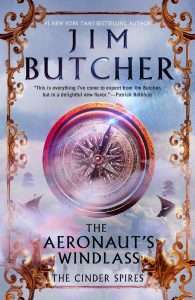 [GdM] James Marsters is now as synonymous with the Dresden Files audiobooks as he is as Spike from Buffy the Vampire Slayer. Are you developing a similar relationship with Euan Morton?
[GdM] James Marsters is now as synonymous with the Dresden Files audiobooks as he is as Spike from Buffy the Vampire Slayer. Are you developing a similar relationship with Euan Morton?
[JB] I’ve never met Euan, but I hope to have the chance some day! He’s an amazing reader, and I very much hope we’re able to retain him for the length of the series.
[GdM] How would you describe a hero? Is Harry a hero, or is Tavi from Codex Alera? Does that differ from how you view a hero as a novel reader and not the author? Or is it impossible to separate the two?
[JB] My writing teacher always taught us to call the central character of the novel a “protagonist” rather than a hero, and I’ve maintained that practice my whole career. Not all protagonists are heroic, and not all heroic characters are protagonists. For writing purposes, I see them as completely unconnected roles.
That said, a hero is someone who runs toward danger, who steps up in a crisis to brave risks to themselves in order to protect others. A hero is anyone who stands between the threats and predators of the world and their would-be victims and says, “No.” A hero is some who sacrifices their own interests to benefit those who cannot help themselves.
My dad was a hero.
[GdM] What was the process for adapting “Dresden Files” for a graphic novel? Do you have similar plans for “The Cinder Spires?” Is writing for the adaptation to a graphic novel the same creative space as writing a book?
[JB] They let me write one script for one graphic novel, after which we all decided we’d be better off hiring a professional in the field and letting me give him an outline to use as a foundation. The graphic novels owe much more to the talent of Mark Powers than they do to me.
I’d be terribly pleased to see a Cinder Spires adaptation, but it hasn’t happened yet.
[GdM] I read that the “Codex Alera” novels are based on two supposedly lame ideas, Pokemon and Lost Roman Legion. Is that true, and if so, was your friend impressed with the outcome? Does “The Cinder Spires” series have an origin story as well?
[JB] I don’t know exactly what you’ve heard, but I did put those books together on a bet, in order to win an online argument. I was challenged to use a terrible idea to write a good story, and I demanded he give me TWO terrible ideas. He did. The story came together, and wound up being half a dozen novels.
The Cinder Spires came to me while driving home from a LARP with a minivan full of sleeping teens. I was listening to Downward Spiral by Nine Inch Nails, while racing an enormous thunderstorm home, and the first couple of chapters just appeared in my head.
[GdM] Can you tell readers about The Olympian Affair and where we are in the story?
[JB] In the world of the Cinder Spires, war is brewing between two major Spires, Albion and Aurora. Fleets of airships armed with energy weapons are on the brink of major war, and both Spires are trying to convince other major Spires to join their side in the coming conflict, or at least to take a stance of constructive neutrality. A major trade summit at Spire Olympia sets the stage for intrigue, alliances, betrayals and general skullduggery in the last days before the war. Lord Albion, Spirearch of Spire Albion, has charged Captain Grimm and his crew with the task of supporting the diplomatic mission to Olympia.
If only the enemy didn’t have other ideas.
[GdM] What is Warriorborn: A Cinder Spires Novella? And where does it fit into the series progression?
[JB] Warriborn is a novella set immediately before the events of the Olympian Affair. It centers on Sir Benedict Lancaster-Sorellin, who leads a small team of warrioborn—super soldiers, born with the prowess of lions in their blood—to a remote Spire to recover vital intelligence for the Spirearch. Unfortunately, the Aurorans got their first, and Benedict soon finds himself in a desperate race to survive both Auroran warriorborn and terrible surface creatures, while simultaneously trying to herd a small tribe of cats.
Think of it as a Bond mission at the beginning of the movie. It won’t be necessary to have read the novella to follow the novel.
[GdM] What are the major themes of “The Cinder Spires” series? Do these differ specifically in The Olympian Affair?
[JB] Talking cats. Come on. Everyone is there for the cats. We all know it, it’s just that no one wants to admit it.
I don’t spend a lot of time thinking about themes while I write—they just appear naturally there when you craft a story properly. I often don’t realize what the theme of one of my books is until months or years after it’s been published.
But I promise there are cats in The Olympian Affair.
[GdM] Chicago, the backdrop of Dresden Files, has a rich cultural history, both good and bad. This city plurality fits because Dresden is undoubtedly a grey character. Setting-wise, are aspects of the “The Cinder Spires” worldbuilding reflected in the characters?
[JB] I just write down the conversations of my imaginary friends. I don’t do it on purpose. But if I’m building the world properly, it’s inevitable that it will happen on its own. If you take the time to make sure that characters truly walk and breathe and eat and think in a world with enough dimension to feel real, they’re going to embody aspects of it whether you want them to or not.
[GdM] The characters in The Cinder Spires are eclectic and have a defined voice in the narrative. How do you craft a varied cast and ensure their voices shine through?
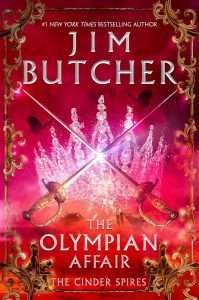 [JB] Mostly by making them as distinct from one another as I can. They come from very different backgrounds and very different upbringings, so of course they’re going to see the same things from different perspectives. They’ll have different priorities and prerogatives, and those differences will be reflected in their goals and how they choose to go about them.
[JB] Mostly by making them as distinct from one another as I can. They come from very different backgrounds and very different upbringings, so of course they’re going to see the same things from different perspectives. They’ll have different priorities and prerogatives, and those differences will be reflected in their goals and how they choose to go about them.
[GdM] The concept of etherealists, crystals, and the magic system, in general, is unique. How did you approach the magical system creation for the series, and were you inspired by anything?
[JB] I really enjoy how Sanderson plays with his magic systems in Mistborn, and I wanted to play too! Between that and beginning with the notion “any sufficiently advanced system of magic will be indistinguishable from technology,” I had a great time creating these characters who can basically do what engineers can do—but skip all the troublesome bits with designing devices in the middle.
[GdM] Having magic and technology in a story can be delicate. How do you ensure that the two aspects complement each other and that one does not outshine the other?
[JB] I don’t see any problem with one outshining the other, depending on what you want to do with your story. That said, regardless of the story universe, magic tends to be something intimately personal, while technology is almost by definition impersonal, made for just anyone to use. So I use magic for the up-close stuff, technology for the broader story issues, and so far it seems to work out.
[GdM] How many books do you have planned for The Cinder Spires series?
[JB] Depends on the audience, who are ultimately my bosses. I’ve got outlines for a three, six, or nine book series. Assuming copies keep moving, I’ll keep writing, but I think six will probably be just about right to tell a really good story.
[GdM] What are you reading right now?
[JB] The Blood Trails series by independent author Jennifer Blackstream! Excellent urban fantasy, strong on mystery, written by someone who clearly loves to solve puzzles.
READ THE OLYMPIAN AFFAIR BY JIM BUTCHERThe post An Interview With Jim Butcher appeared first on Grimdark Magazine.
REVIEW: The Blood Stones by Tori Tecken
Tori Tecken pours a lifetime’s love of fantasy into The Blood Stones, the masterfully written first volume of her new dark epic fantasy series, Legends of the Bruhai.
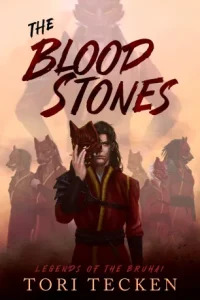 The novel opens with Gehrin, a young boy who, against his father’s wishes, witnesses the execution of a man sentenced to death for murder of the prince. The condemned man is officially nameless, a traitor meant to be forgotten in the annals of history. However, the piercing gaze of the dying man leaves an undying impression on Gehrin.
The novel opens with Gehrin, a young boy who, against his father’s wishes, witnesses the execution of a man sentenced to death for murder of the prince. The condemned man is officially nameless, a traitor meant to be forgotten in the annals of history. However, the piercing gaze of the dying man leaves an undying impression on Gehrin.
Upon returning home, Gehrin is chastised by his father, a government counselor:
“A traitor must leave the earth nameless, forgotten. Yet now you will remember him.”
His dreams are haunted by the specter of the dying man, and Gehrin is abducted under the cover of night, taken to a mysterious school of boys who seem to have lost their identities. Gehrin struggles to maintain his own identity in an environment that wishes to wash it away.
I was particularly touched by Tori Tecken’s descriptions of young Gehrin, who feels small and wants to disappear in the face of such an imposing evil, but who also recognizes that he must make himself big to face the challenges ahead:
“In the darkness of the little box bumping along some unknown road, Gehrin had never felt more like a small boy. Tears squeezed out of his eyes and dripped down his cheeks. He impatiently tried to sweep them away, but his bound hands bumped against his still tender face, and he winced. He choked back a sob, the fear and the slow torture of the lurching movements driving him further away from his determination to stay strong.”
Meanwhile, in the neighboring tribal lands, we are introduced to the second lead protagonist, Syndri, the daughter of a chieftain who lives in a seemingly unending cycle of violence, killing to bring honor to her people. Syndri’s plotline is full of intense action and political manipulation that seems destined to intersect with Gehrin’s story. The latter half of The Blood Stones is full of action, and Tori Tecken has writing action scenes down to an artform.
The Blood Stones is brilliantly plotted across both storylines, with perfect pacing and several unexpected twists that I did not see coming. Tori Tecken introduces elements of worldbuilding in a very natural fashion without any awkward info dumps that sometimes mar epic fantasy. She succeeds in building a complex world without ever making the reader feel overwhelmed or confused.
The Blood Stones is light on magical elements with a primary emphasis on character development. Beyond Gehrin and Syndri, I also enjoyed the cast of secondary characters, especially Gehrin’s older brother, Xario, who is a more archetypal hero figure but still struggles to meet the expectations set on him:
“But being almost a man was the same as still being mostly a child.”
Tori Tecken writes like a seasoned veteran in epic fantasy, hooking me from the first page. Her writing is compulsively readable and polished to perfection. Tecken has a knack for writing the perfect ending to each chapter, making it virtually impossible to set the book down. In a delightful nod to classic epic fantasy, Tecken also gets bonus points for the mouthwatering descriptions of food:
“The tangy lemon scent wafted between them. Gehrin inhaled a deep whiff of the kiji before biting into the soft, chewy rice cake. Mint and jasmine swirled together on his tongue, familiar and comforting.”
I hope someday there will be a companion cookbook.
Tecken also excels in her realistic depictions of friendship among the young cast of characters against the backdrop of a very dark world. In this regard, The Blood Stones reminds me of Mark Lawrence’s Book of the Ancestor trilogy, especially its first volume, Red Sister. Tecken also invokes a Lawrencian level of eloquence and accessibility in her approach to storytelling.
As in Tecken’s recently published young adult fantasy, Phased, The Blood Stones excels in its portrayal of mental health struggles, especially related to issues of identity. The Blood Stones also explores themes of memory in a land of forgetting.
The Blood Stones is epic fantasy par excellence, Tori Tecken’s love letter to the genre and a tour de force of worldbuilding and character development that will capture your imagination from the first page and keep you guessing till the very end.
5/5
Read The Blood Stones by Tori TeckenThe post REVIEW: The Blood Stones by Tori Tecken appeared first on Grimdark Magazine.
November 16, 2023
An Interview With Patrick Rothfuss
Patrick Rothfuss, philanthropist and author of the “King Killer Chronicle” and the newly released The Narrow Road Between Desires, was initially slated to sit down with John Mauro and myself and over a half-hour interview to briefly discuss the new novel. However, what happened next was a great conversation that spanned years of reading between the three of us, writing, reviewing, Pat’s philanthropy, and more.
Because of the length of this interview and our conversations, we have had to split the discussion into three parts. John and I learned a lot about Pat, literature, and the future of the genre. Join us on this adventure with one of the most prominent figures in fantasy. We hope you enjoy it as much as we did.
Read The Narrow Road Between DesiresThe post An Interview With Patrick Rothfuss appeared first on Grimdark Magazine.
November 15, 2023
REVIEW: Traitor of Redwinter by Ed McDonald
Traitor of Redwinter is the latest book from fantasy author Ed McDonald. It is the second of The Redwinter Chronicles, and like the first novel in the series Daughter of Redwinter, it is an epic fantasy blended with magical mystery. The Redwinter Chronicles are my first experience with McDonald’s writing. Still, readers may also know him from his completed The Raven’s Mark trilogy, which I have purchased based on how much I loved The Daughter of Redwinter and The Traitor of Redwinter. Like many things in life, there is a particular type of book I can almost guarantee I will enjoy – epic fantasy, some magic, some political manoeuvring, some dubious morals, and the odd battle. Not only does McDonald’s Traitor of Redwinter have all of these things, he has done them very well. If I was not reading this book, I was thinking about it, and I was so sad to finish it because I was not ready to let go. McDonald has firmly ensconced himself in my auto-buy list because of these two books, a place he shares with the likes of Mark Lawerence, Robin Hobb, and Joe Abercrombie. If those writing maestros are also your reading cup of tea, I would expect you to enjoy Ed McDonald’s writing immensely.
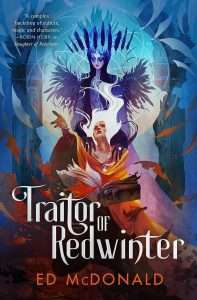 The Daughter of Redwinter is essential pre-reading before starting Traitor of Redwinter. Still, you do not have to have done this very recently, as McDonald provides a handy synopsis before the novel proper. There are also a Dramatis Personae and notes on the Mystical World at the rear of the book to help you keep the different Lacs and their clans in check. Traitor of Redwinter continues to follow Raine and her time navigating the world around her. Not just her struggles with controlling her necromancy (and the risks that this poses), but the politics of Redwinter and the wider world, socially dealing with the traumas from the first novel and trying to find a firm footing in the LacNaithe household as an Apprentice Draohin. The Raine in Traitor of Redwinter is quite different (because of the removal of the magical ‘block’ placed on her in the first novel), and I feel like this vulnerability which made her a lot more human. In Daughter of Redwinter, the lack of emotions made her more challenging to relate to, whereas in Traitor I cared for her as a character rather than just the fate of the world she was in. I think some readers might not like the emotional shift in Raine, especially her dealing with romantic attachments, as this did not feature very highly in the first novel. Still, I found it to be an essential part of her characterisation and written with great care by McDonald. Raine never feels like a caricature or a diversity check box, she is just Raine.
The Daughter of Redwinter is essential pre-reading before starting Traitor of Redwinter. Still, you do not have to have done this very recently, as McDonald provides a handy synopsis before the novel proper. There are also a Dramatis Personae and notes on the Mystical World at the rear of the book to help you keep the different Lacs and their clans in check. Traitor of Redwinter continues to follow Raine and her time navigating the world around her. Not just her struggles with controlling her necromancy (and the risks that this poses), but the politics of Redwinter and the wider world, socially dealing with the traumas from the first novel and trying to find a firm footing in the LacNaithe household as an Apprentice Draohin. The Raine in Traitor of Redwinter is quite different (because of the removal of the magical ‘block’ placed on her in the first novel), and I feel like this vulnerability which made her a lot more human. In Daughter of Redwinter, the lack of emotions made her more challenging to relate to, whereas in Traitor I cared for her as a character rather than just the fate of the world she was in. I think some readers might not like the emotional shift in Raine, especially her dealing with romantic attachments, as this did not feature very highly in the first novel. Still, I found it to be an essential part of her characterisation and written with great care by McDonald. Raine never feels like a caricature or a diversity check box, she is just Raine.
I liked almost everything about Traitor of Redwinter. I found it to be well-paced and very engaging. It is a character-driven novel, and I reacted to all the key characters. Most I like, even the slightly sketchier ones, and some I loathe. But to have these reactions shows just how good McDonald’s writing is. In this novel, we learn so much more, without ever being bogged down by world-building, and discover the pasts of some of the more enigmatic characters. The manoeuvring of the politics in and out of Redwinter is done masterfully. I was, at times, literally open-mouthed and had to go back and re-read parts to make sure what I was reading was actually happening. There is a darkness to this series, which will appeal to grimdark fans, but it is not overpowering or unrelenting. Even on the brink of war, there is laughter and lighter moments. Traitor of Redwinter moves on the wider plots of The Chronicles and is a good read in its own right. The stage is set perfectly for what I expect to be a fantastic conclusion.
I want to pass on a huge thank you to Ed McDonald and the team at Gollancz for sending me both The Daughter of Redwinter and The Traitor of Redwinter so that I could provide this review. However, having read these two almost back to back, the wait for the next book will be tough!
4.5/5
Read Traitor of Redwinter by Ed McDonaldThe post REVIEW: Traitor of Redwinter by Ed McDonald appeared first on Grimdark Magazine.
November 14, 2023
REVIEW: Iron Gold by Pierce Brown
In Pierce Brown’s Iron Gold the Ash Lord and the Last Fury hold Venus as their final bastion of the old order of the Society, and Darrow returns home to petition the senate for enough troops for one last push to finish the war. Out on the rim, mistakes have consequences that threaten to throw the entire solar system back into never-ending stalemate, while back in the heart of Rising territory the political move from a military society to a democratic one is not as easy as Virginia and her allies hoped for. In yet another heart-wrenching, reproductive-pieces-to-the-wall action packed masterpiece, Pierce Brown picks up where he left off in Morning Star.
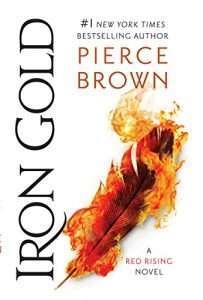 Darrow’s decisions come back to haunt him in Iron Gold. Throughout ten years of war he has made some hard decisions, some rash decisions, and some flat out wrong decisions–and some of those debts are about to come home to demand payment. He goes to face the senate for ordering the Iron Rain on Venus against their orders. As he relaxes with his family and friends and desperately tries to unwind from ten years of war, we see into his restlessness and his inability to let the war go, as he struggles to transition from leading by authority to being a part of a democracy where he is no longer in absolute power. Pierce also really begins to dig into Darrow’s life as a soldier and a figurehead, and the impact of that on Virginia and his son, Pax.
Darrow’s decisions come back to haunt him in Iron Gold. Throughout ten years of war he has made some hard decisions, some rash decisions, and some flat out wrong decisions–and some of those debts are about to come home to demand payment. He goes to face the senate for ordering the Iron Rain on Venus against their orders. As he relaxes with his family and friends and desperately tries to unwind from ten years of war, we see into his restlessness and his inability to let the war go, as he struggles to transition from leading by authority to being a part of a democracy where he is no longer in absolute power. Pierce also really begins to dig into Darrow’s life as a soldier and a figurehead, and the impact of that on Virginia and his son, Pax.
Lyra is our view into the lives that Darrow and Virginia have freed. It’s a life of refugee camps and struggle, and really showcases that freedom doesn’t mean freedom from struggle or prejudice or death. It’s an endless war against hatred and the collective self of human society in all its dirty individual brutality, and shows that the glowing lights of the heads of state can paint a picture of glory and life but in the end the destitute always suffer and die, no matter who is in charge. If there’s a better SFF depiction of a Syrian refugee watching the West revel in their victorious glory from afar delivered in one chapter of SFF, I don’t think I’ve ever seen it.
Effram is your more stock standard, knees groaning, cynical-as-fuck war veteran moved into the dark mercenary arts and I am here for it. The older I get and the more I groan when I wake up and wonder how this happened, the more I love this trope. In this case he’s an art thief leading a young crew of experts to steal the sword of the Lightbringer—the Gold who led the ancient war to wrest Earth from old humanity. Only, he’s stolen from somebody you shouldn’t steal from, and he’s about to lose control of his life and drag his crew down with him.
Lysander is with Cassius near the Outer Rim trying to restore honour to Gold by protecting the needy, versus dominating them, when they encounter an emergency call and run into a threat potentially greater than the war between the Society and The Uprising.
The opening scenes of Darrow and his family and friends reflecting on their lives and world and the job ahead does well to reset us as the reader into this world. Pierce really goes for the reader’s throat to nail down the friendships they’ve built and earned and lost, and sets an incredibly morose mood for Darrow’s chapters throughout the book. If anything, the three new points of view helped keep the book moving as we got really down in the dumps with Darrow throughout his chapters in a very emotionally insightful story arc. If I had one complaint about this book (pretty sure it’s my first one, four books in) it’s that the emo-hammer fell a bit hard for me throughout his story arc, and without the other points of view, I likely wouldn’t have enjoyed the book as much.
Brown, as always, is a magnificent storyteller overall. As we move throughout the solar system, amongst the many factions, and watch in horror as mistakes and battles and cruelty bury millions, and infighting buries even more, he juggles the brutality of politics, war, factional divides, and new dangers for the emotionally weary reader like an orchestra conductor. Effram and Lyra were the stars of this show for me, and they showcased Brown’s ability to really flesh out this world he’s built through different perspectives, without it feeling completely different to what we’ve come to expect from him. And with 24hrs of audio to listen to on this book voice by four different narrators (shout out to the great work of Tim Gerard Reynolds, John Curless, Julien Elfer, and Aedin Molony), you know you are being taken very deep into this world.
Iron Gold is a magnificent bridge to the next books, with the additional points of view ramping up the scope and stakes of Brown’s world, and the strain on Darrow’s friendships and loves ratcheting up the emotional tension to match the physical danger of war in the future. Highly recommended.
Read Iron Gold by Pierce Brown
The post REVIEW: Iron Gold by Pierce Brown appeared first on Grimdark Magazine.
November 13, 2023
REVIEW: Universal Monsters: Dracula #1 by James Tynion IV (W) and Martin Simmonds (A)
Mother of God. Mother of God. Reading Universal Monsters: Dracula #1 is like mainlining your illicit drug of choice straight into your temporal lobe. And then doing it again, and again, and yet again, until you lie prostrate on the ground, emotionally and physically shattered, but utterly thrillingly gobsmacked at the same time.
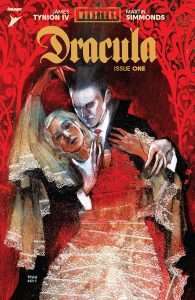 Universal Monsters: Dracula #1 is not based on the novel by Bram Stoker (though it does feature the same characters) but instead takes its queues, as the title hints, from the 1931 Todd Browning directed version, based in part of the Broadway production. As such, Renfield takes the role of Harker, in that it is Renfield who goes to Transylvannia to transact legal business with our favourite blood sucking fiend, and returns via the Vesta before being condemned to a lunatic asylum where he proceeds to eat every insect known to man. And then stuff gets really real…
Universal Monsters: Dracula #1 is not based on the novel by Bram Stoker (though it does feature the same characters) but instead takes its queues, as the title hints, from the 1931 Todd Browning directed version, based in part of the Broadway production. As such, Renfield takes the role of Harker, in that it is Renfield who goes to Transylvannia to transact legal business with our favourite blood sucking fiend, and returns via the Vesta before being condemned to a lunatic asylum where he proceeds to eat every insect known to man. And then stuff gets really real…
As I intimate in the opening, Universal Monsters: Dracula #1 is an assault on your visual senses. Martin Simmonds artwork is a masterclass in how ink and the judicious use of colour (though frankly Simmonds goes berserk with the way he splashes colour around during this opening issue, and it is a total sensory freakout when he does so) can elevate the material beyond the page itself. Simmonds is also excellent at creating unnerving scenes, particularly anything featuring Renfield, whom he depicts with a white face around a mouthful of needle sharp teeth. Check out page 3 – Renfield stares straight at the reader with bloodshot blue eyes, the whiteness of his skin (testimony to Dracula battening on him body and soul) obliterating his features, reducing the man down to a bundle of needs and neuroses, culminating in him approaching Seward with his teeth bared and hunger stamped in every pore of his being…
These and a half dozen other wonderful images elevate Universal Monsters: Dracula #1 above the standard comic book fare.
Writer James Tynion IV has done well to distil the essence of the film adaptation into this opening salvo. Universal Monsters: Dracula #1 is slightly disorienting if, like me, your sole exposure to Bram Stoker’s creation is the novel, and not the myriad adaptations such as Nosferatu or the 1931 movie itself. But all the main elements are present, and all handled very well. Essentially, Universal Monsters: Dracula #1 is an introduction not only to this slightly sideways world, but also the characters themselves. Renfield is easily the highlight, but then even a slightly inebriated chimpanzee could do something with this crazed, insect obsessed paranoiac, howling at the moon in praise of his master one moment, and in the next, expostulating at length about his master’s true (and frankly horrifying) plans for humanity. It is gripping stuff.
I could go on even longer about how blazingingly fantastic Universal Monsters: Dracula #1 is – the artwork is like pure adrenaline for the mind – not only the way Simmonds makes the world a shadowy, hazy, and hard to pin down bedlam for the characters, but also when Dracula is on the hunt – the world dissolves away into disparate images of blood, blazing eyes weeping blood, and a cyclone of ravening beasts and bats that all resolve into the caped fiend himself.
Universal Monsters: Dracula #1 is one of the best comics I’ve read this year. For those of you who read with fanatic interest Tynion and Simmond’s The Department of Truth, Universal Monsters: Dracula #1 is a step up in terms of writing and art. For those of you reading this in the Northern Hemisphere, this issue, and the series itself, promise to be a delightfully frightful way to embrace the long, cold nights, and the things that haunt it.
5/5
Purchase links:US KindleUK Kindle
The post REVIEW: Universal Monsters: Dracula #1 by James Tynion IV (W) and Martin Simmonds (A) appeared first on Grimdark Magazine.
November 12, 2023
REVIEW: Conan the Barbarian #4 by Jim Zub (W) and Roberto De La Torre (A)
Our hero is already in dire straits at the opening of Titan Comics’ Conan the Barbarian #4. The struggle between Conan and the high priest of the Black Stone cult has plunged them both into the deep emerald-green waters at the core of the temple. Tentacles rise to meet the barbarian as he sinks into the murky abyss, and he pledges to slay the cult’s misshapen deity, even if it costs him his own life. As he begins to drown, however, he sees a vision of an ancient Pictish chieftain. This echo from the past provides Conan (and the reader) with some welcome backstory. Conan learns more about the mysterious black stone that has had such a malign influence on the countryside, and how he has become embroiled in a hidden struggle against the occult dating back tens of thousands of years. While his ghostly benefactor is unable to provide Conan with direct aid, the brief conversation steels his resolve, and—lungs bursting—he swims down to meet his godlike foe.
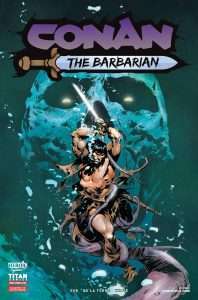 Conan the Barbarian #4 is the conclusion of “Bound in Black Stone,” the first story arc in this latest Conan comic. Jim Zub’s narration was solid and evocative as usual. The ancient Pict is a figure that will be instantly recognizable to those who have read “The Shadow Kingdom” (1929) or Robert E. Howard’s other King Kull stories. Kull’s Thurian era is the distant past of Conan’s own Hyborian Age, and it was fun to see Zub link these two distant epochs. The essays by Jeffrey Shanks at the end of each issue go to great lengths to point out the connections between various corners of the Howard literary universe and, like Thulsa Doom being name-dropped in issue #3, it appears that Zub is very intentionally laying the groundwork for future cross-pollination between Howard’s heroes and settings.
Conan the Barbarian #4 is the conclusion of “Bound in Black Stone,” the first story arc in this latest Conan comic. Jim Zub’s narration was solid and evocative as usual. The ancient Pict is a figure that will be instantly recognizable to those who have read “The Shadow Kingdom” (1929) or Robert E. Howard’s other King Kull stories. Kull’s Thurian era is the distant past of Conan’s own Hyborian Age, and it was fun to see Zub link these two distant epochs. The essays by Jeffrey Shanks at the end of each issue go to great lengths to point out the connections between various corners of the Howard literary universe and, like Thulsa Doom being name-dropped in issue #3, it appears that Zub is very intentionally laying the groundwork for future cross-pollination between Howard’s heroes and settings.
De La Torre’s artwork maintains the high standard of quality seen in the previous issues. The forceful and dynamic posing of characters during the combat scenes was especially noticeable in this installment.
While I found Conan the Barbarian #4 largely successful, I was left baffled by some of the creative choices. The Pict warrior woman Brissa was one of the most talked-about elements of the new series, but she was completely absent from this issue. Mentioned briefly, but not shown. The tropes of comic storytelling being what they are, it’s painfully obvious that we haven’t seen the last of Brissa (Zub has hinted as much in interviews), but it felt like an unfair and anticlimactic way to handle an exciting supporting character.
The battle between Conan and the tentacled aquatic creature felt like another missed opportunity. Generally, in this situation a Conan the Barbarian reader would expect to be treated to some particularly impressive artwork, perhaps even a two-page spread revealing the blasphemous alien god in all its glory. Somewhat disappointingly, De La Torre delivers an unexpectedly subdued combat against a mostly hidden monster.
While my enthusiasm for Titan Comics’ Conan the Barbarian remains high, the finale of “Bound in Black Stone” didn’t quite attain the heights of preceding issues. The creative team have demonstrated their formidable capabilities, but this time it felt like they weren’t operating at full strength. I’m excited about the foundation Zub seems to be constructing for future stories and even upcoming titles featuring other Robert E. Howard heroes, but it seemed like the story’s immediate present was underserved. And Conan is a character that lives in the moment.
Read Conan the Barbarian #4 by Jim Zub (W) and Roberto De La Torre (A)The post REVIEW: Conan the Barbarian #4 by Jim Zub (W) and Roberto De La Torre (A) appeared first on Grimdark Magazine.
November 11, 2023
REVIEW: A Fortress of Grey Ice by J.V. Jones
A Fortress of Grey Ice is the second entry in J.V. Jones’ Sword of Shadows series. The novel is another impressive character-driven epic fantasy, continuing the action that was introduced with A Cavern of Black Ice. The scope has been expanded this time, giving readers more insights into both the happenings of the clan wars and Panthero Iss and his forces at Spire Vanis using the turmoil to their advantage. We are presented with further understandings surrounding the world’s magics, political factions and complications. The main threat is bubbling beyond the blindwall and the majority of the dramatis personae are oblivious to this nightmare presence. The Endlords and their shadowy taken are currently behind the magical veil but this protection is constantly weakening.
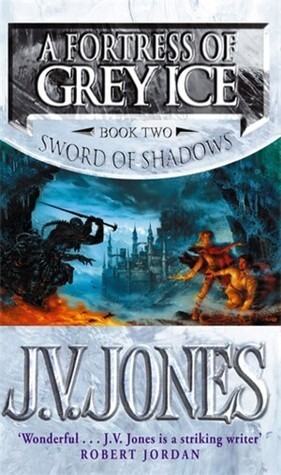 My favourite character and point of view perspective to follow was Raif’s, who is akin to this series’ Jon Snow. His chapters include hardships, unequivocally difficult decisions, truly incredible setpieces, and great support characters, such as Stillborn. The concept of the Maimed Men is one of the most intriguing groups I can remember being introduced to in a dark fantasy narrative. Being ostracised from his clan, there are not many options for Raif, leading him down some harrowing roads, littered with (what have to be) the series’ standout moments.
My favourite character and point of view perspective to follow was Raif’s, who is akin to this series’ Jon Snow. His chapters include hardships, unequivocally difficult decisions, truly incredible setpieces, and great support characters, such as Stillborn. The concept of the Maimed Men is one of the most intriguing groups I can remember being introduced to in a dark fantasy narrative. Being ostracised from his clan, there are not many options for Raif, leading him down some harrowing roads, littered with (what have to be) the series’ standout moments.
“Yes, Clansman. I know who you are. I have seen the raven riding on your back. I have heard the sound of footsteps at your heels. Death follows you. She named you. Watcher of the Dead. Yes, you are cursed.”
Unfortunately, I was not as enthusiastic about Ash’s point of view chapters this time although I understand their importance and necessity, diverting her away from the other main players, plot-wise and with regards to her fate in this story. Finding out further details about the Sull, though, was a positive from these sections.
“We are the only ones left who fight the darkness. Whilst clansmen and city men feud amongst themselves over land once claimed by the Sull, we will ride out and battle with the Endlords and their taken. Make no mistake, Ash March, I offer you little in return for your soul.”
Another excellent progression in A Fortress of Grey Ice was the internal conflict, and civil war storyline, following a self-styled King of Dhoone (Robbie the Thorn King), through the observant eyes of his 15-year-old younger brother Bram. These chapters featuring Robbie, Bram, and the King’s forces are action-packed, showing insights into the loyalty and unification that the would-be monarch inspires. Another aspect of these segments was Scotland-inspired imagery and language which I thought was a great touch, possibly more so as I read some of this novel whilst on a trip to Glasgow.
The Dog Lord’s page time is just as enjoyable to follow as the last book, Angus Lok is still enigmatic and influential although does not frequent the drama as much as in A Cavern of Black Ice, and new points of view, delivered by Raina Blackhail and Crope, are interesting too. Raina is the clan chief of Blackhail’s wife and Crope is a misunderstood giant of a man with a mysterious past and an allegiance that binds him.
I would have wished to have spent longer periods witnessing events through Raina’s eyes but like Effie Sevrance (Raif’s 9-year-old sister), their moments are impactful but seem less frequent. Right now, danger and uncertainty stalk Effie Sevrance’s heels, with her being witness to and part of one traumatic scene in particular. This occasion was thrilling, emotionally intense, and draining. Even though I am aware this is a grimdark read, I could not help but hope that some hero would arrive at the last moment, bellow “stop this nonsense now!” and the darkness and dread would dissipate. Alas, this is not to be the case in Jones’ frozen and cruel world. Any character who could be referred to as a typical hero has probably already been murdered or is off fighting on the fringes, placed there so that they are unable to influence these plot points, however much they would want to.
A final note before I conclude: I wish to bring attention to the fact that Traggis Mole is an incredible character. To me, one of the finest grimdark side characters I have come across. Utterly dangerous and formidable, respected and feared, and although his agendas seem nefarious, he may have less dastardly motives than it first seems. Every interaction that featured him, I felt as if something was about to explode. I was upset that I could not find any fan art of him, this, unfortunately, represents that this series does not seem to have the size and dedication of readership that the quality befits.
“As the Robber Chief turned away, his gaze met Raif’s. Traggis Mole’s eyes were black and haunted, and there was such a force behind them Raif fought the desire to step back. Harm us and die, the Robber Chief warned him, and then swept his gaze away.”
A Fortress of Grey Ice is another top-tier fantasy read, with an intricately crafted plot that is deep and a joy to get lost in and that statement takes into consideration my prior awareness that this journey is painful, and will continue to be so. My only real complaint is that there are a few plodding and duller moments but as an overall package, the standard is high. 8.5/10.
Read A Fortress of Grey Ice by J.V. JonesThe post REVIEW: A Fortress of Grey Ice by J.V. Jones appeared first on Grimdark Magazine.
November 10, 2023
REVIEW: Sword Catcher by Cassandra Clare
Cassandra Clare’s first foray into adult fantasy comes in the form of Sword Catcher, the first book in a planned quartet that follows Kellian, or more affectionately known as Kel, as he is forcefully taken from an orphanage and ceremoniously placed in the jaws of Castellane’s Royal Family. Kel is effectively thrust into a world of duplicity, where he is trained to become the body double of the Crown Prince, and essentially a bodyguard in the same breath, thus becoming the ‘Sword Catcher’. We also follow Lin Caster, a female physician, who is sequestered within a city specifically for the Ashkar, a community looked down upon for their rare magical abilities. Lin’s greatest desire is to cure her closest friend from a seemingly incurable illness, and she is willing to cross the boundaries of magic to do so. Both protagonists are tied to a thread at the hands of the Ragpicker King, the mastermind that runs Castellane’s criminal underworld. Both protagonists are offered allegiance with the Ragpicker King – but at what cost? Sword Catcher is the indulgent introduction to a series bursting at the seams with political intrigue and magical unrest.
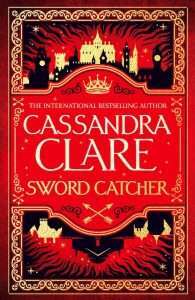 The grimdark element to Sword Catcher is subtle, in that the violence and amorality is built into the bricks of Castellane’s foundation. The wealthy reside upon high hills, fervent with their riches and away from the commoners, while the most corrupt of criminals run the streets below. Whilst rolling greens and city streets separate them, their goals are the same: power, money and the thrill of debauchery. The city of Castellane itself is even bordered with a moat, home to crocodiles who are often fed political prisoners and criminals alike. I find that whilst Sword Catcher is not explicit in its categorisation as grimdark, it most certainly borrows aspects of the genre and skilfully threads it into the world building.
The grimdark element to Sword Catcher is subtle, in that the violence and amorality is built into the bricks of Castellane’s foundation. The wealthy reside upon high hills, fervent with their riches and away from the commoners, while the most corrupt of criminals run the streets below. Whilst rolling greens and city streets separate them, their goals are the same: power, money and the thrill of debauchery. The city of Castellane itself is even bordered with a moat, home to crocodiles who are often fed political prisoners and criminals alike. I find that whilst Sword Catcher is not explicit in its categorisation as grimdark, it most certainly borrows aspects of the genre and skilfully threads it into the world building.
Cassandra Clare’s writing has a reminiscence to it. As if those who grew up reading the Shadowhunter Chronicles have been given space to explore the adult fantasy genre in the skin that they have been so comfortable in all these years when following her previous series. Whilst the worlds are vastly different, Clare’s strongpoint across all her work is her characterisations. She has the unique ability of making her readers severely attached to her characters. Kel is a fine young man, and a thrilling protagonist; he is witty, smart and multi-faceted. His struggle with identity takes the centre of his characterisation in this book, as we find he struggles to grasp on to who he truly is and who he is supposed to be. You would expect him to develop a sort of hatred towards the Prince he is to die for, but he is instead fiercely protective of him, which I found quite refreshing. His friendship with Conor falls into the remit of brotherhood (not a theme unfamiliar to Clare), and it is truly one of my highlights of the novel. In a Court of corruption, the love between Kel and Conor is a beam of light. Conor is the most morally lenient of the two; he never truly does anything quite immoral, but he often toes the line. At a Sword Catcher event, Clare stated that ‘loving Kel is Conor’s great humanising quality’, which I think encapsulates Conor’s characterisation well, in that his affection for Kel is what tethers him to the reality of what is expected of him as the Crown Prince. Lin Caster is a fierce character, shunned for what she believes in, a blueprint for many female protagonists in fantasy. This does not make her boring or repetitive; although I do feel as if we have only seen a fraction of her personality in this book. I would have loved to have learned more of her and her Ashkari magic, as the tidbits we are privy to in this book are super fascinating.
Sword Catcher is both dense in size and in world-building, but is never tiresome. Every new detail was fascinating, and fed my understanding of the world. It is important to note that the length of the novel does not give way to a lot of plot. I suspect this was necessary due to the heavy history and politics of Castellane, so that the rest of the series can take off with the right foundations set. This may be off-putting for some readers, but I believe the characters make up for it. I must also note that romance is not the focal point of this novel, which may come as a shock to many, but it is instead an aspect that is alluded to in pockets within the story. Sword Catcher is heavy on the politics, but in a way that I found quite accessible and not convoluted in any way. I warn readers of her previous work to enter with a sort of cautious optimism, as you will find it is not as explosive and fast-paced as her other works, but it is certainly an enjoyable change of pace.
I could not write this review without mentioning how brilliantly detailed Clare has written out this world. Her depictions of various settings, from the courtyards to the ballrooms to the street markets is truly brilliant – you can almost see, smell and taste Castellane. My personal favourite descriptions have to be the ones of Conor’s attire, which were never short of spectacular at all times!
If you are looking for a fast-paced fantasy, rife with twists and turns, then this is not the book for you. However, if you’re in the mood for a solid first book in a series, spanning the themes of a classic fantasy: political intrigue, magic, secrets and conspiracies, then I highly suggest indulging in Cassandra Clare’s Sword Catcher.
Read Sword Catcher by Cassandra ClareThe post REVIEW: Sword Catcher by Cassandra Clare appeared first on Grimdark Magazine.
November 9, 2023
Loud as a Whisper
One of the freeing – and terrifying – things about writing a novel is when the characters take over.
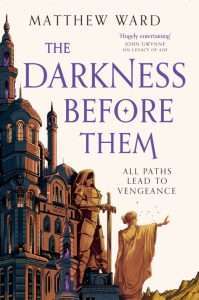 In The Darkness Before Them one character in particular made it very, very clear that they were much more important than I realised. Naturally, yon character didn’t tell me this right from the off – like so many people in my life, my characters breezily assume that deadlines are for other people. Instead, they waited until I was about halfway through before stridently making the case for greater involvement.
In The Darkness Before Them one character in particular made it very, very clear that they were much more important than I realised. Naturally, yon character didn’t tell me this right from the off – like so many people in my life, my characters breezily assume that deadlines are for other people. Instead, they waited until I was about halfway through before stridently making the case for greater involvement.
I’m not saying it wasn’t annoying, but The Darkness Before Them is so much the better for it. More than that, the sequel – The Fire Within Them – became a very different beast … but I’m getting ahead of myself.
(For the record, a similar thing happened in Legacy of Ash, it has to be said. Sevaka was almost cut from the story at one point, but now it’s impossible to imagine Legacy of Steel or Legacy of Light without her. Well done her for speaking up!)
Despite the frustration these forthright characters engender, I’ve always been a big fan of getting out of the characters’ way and leaving them to it.
And when they take umbrage at what the plot wants them to do, I kill them off.
Well, sometimes.
Mostly, I try to listen. After all, they’re living the world 24/7. Me? I’m just visiting. I know how whimsical that sounds, but how else explain the unarguable instinct that warns against doing this or that because it would be out of character for our gallant (or tangentially so) protagonist, sidekick or moustache-twirling villain?
The problem is that characters, being fictional, tend to have very quiet voices that get lost in the grind of the real world day-to-day.
But that’s okay.
I’m going to teach you a trick to hearing your characters even when the world is loud.
We’re all familiar with the idea that characters are built by their choices. These are often “sacrifice X to save Y” dilemmas of some kind, most commonly short-handed as Trolley Problems. If a fight breaks out in an alleyway a character might choose to put themselves in harm’s way to help the victim (hurrah!). Alternatively, they might elect not to take the risk and leave the victim to fend for themselves (booo!).
Less acknowledged is that for every positive choice a character makes, others slip past unremarked because the character never recognised there was a decision to be made. They never even thought about getting involved. It’s just a thing that happened nearby. It might not even rate a mention in their inner monologue. They never even boarded the trolley, in other words.
Leaving a victim to fend for themselves is a choice that says something about your character. However, so does that character not realising that there was a moment of intervention in the first place, even – and this is the important part – if your reader doesn’t realise it either because you never gave them that information.
With me so far? Good. Stick with it.
How can your reader know how these non-choices shape the character if they don’t know that these non-choices exist? They can’t, of course. But we’re not talking about the reader’s relationship with your character. We’re talking about your relationship with your character. Does the uproar in a market square include a plaintive cry for help from a bystander in an alley? You know. You’ve already built the scene in your head. Depending on the setting, this might be a rare occurrence or so commonplace as to not be remarkable.
Either way, somewhere along the road you’ve decided if your character is going to notice the cry for help and not care, not care enough to notice or not even care enough to recognise that there might be a cry of help to notice.
This is your character talking to you.
Every bit of scene setting, every snippet of world building that goes by the wayside? It’s not just you making choices, it’s your characters making choices through you. Especially when it doesn’t matter to the plot either way. And the best bit? Even if you don’t hear your characters speaking when you’re writing the scene, you can re-read it and listen harder. Discount the conscious omissions made for plot reasons, character development, world-building or because you feared your editor was going to give you a hard time. What’s left – that wonderful, unspoken negative space around what was actually said – is where your character speaks. And only you can hear it. You’ve actually been hearing it all along.
The question is: have you been listening?
It’s the sum of these moments – these decisions made without conscious choice – that make your characters adamant that they know best. That the plot, the synopsis, your carefully crafted plans and meanly hoarded sanity can all go hang, because I’m going to go over there and do that instead, thank you very much.
When this happens, listen. Let it happen. Because your character aren’t your characters at all, really. Or at least, they’re not just characters – they’re the piece of you that’s telling the story for the story’s sake.
And when it comes down to it, isn’t that why you’re writing the story in the first place?
Read The Darkness Before Them by Matthew WardThese are dark times for the Kingdom of Khalad. As the magical mists of the Veil devour the land, the populace struggles beneath the rule of ruthless noble houses and their uncaring immortal king.
Kat doesn’t care about any of that. A talented thief, she’s pursuing one big score that will settle the debt that destroyed her family. No easy feat in a realm where indentured spirits hold vigil over every vault and treasure room. However, Kat has a unique talent: she can speak to those spirits, and even command them. And she has no qualms using her power to her advantage.
Kat’s not a hero. She just wants to be free. To have her old life back. But as rebellion rekindles and the war for Khalad’s future begins, everyone—Kat included—will have to pick a side.
The post Loud as a Whisper appeared first on Grimdark Magazine.



